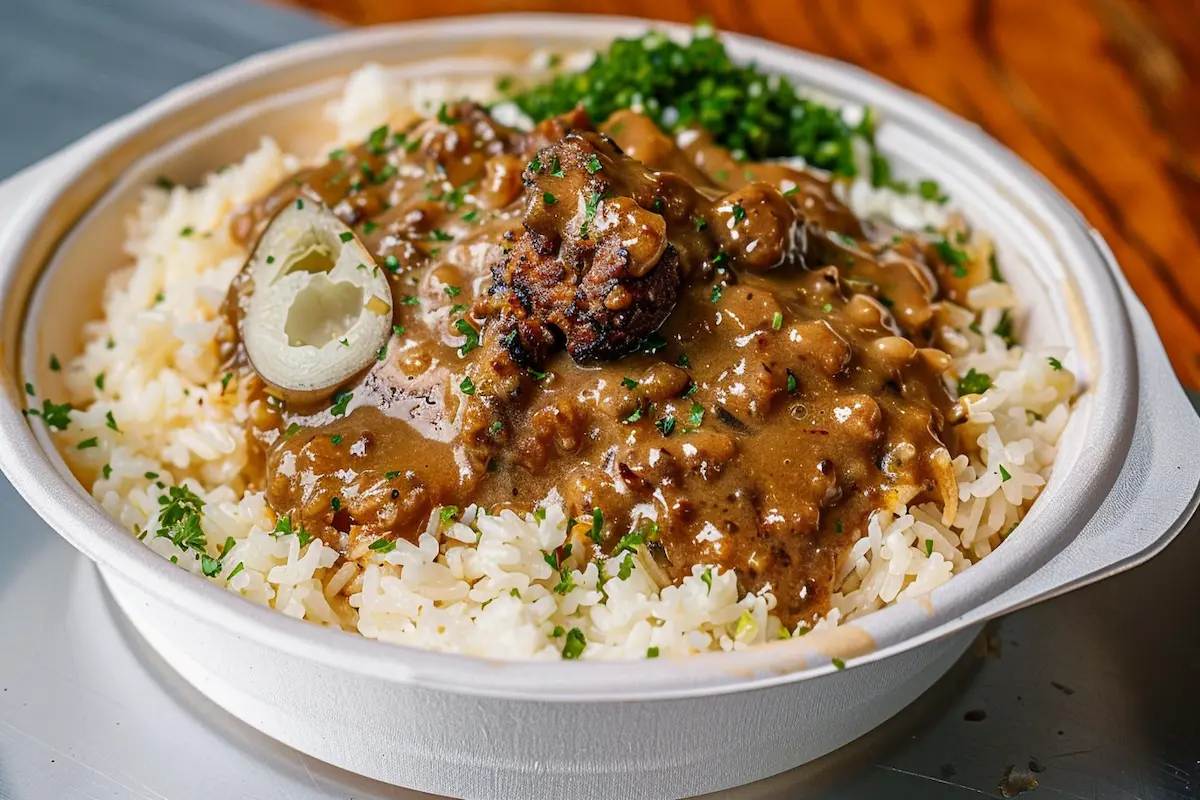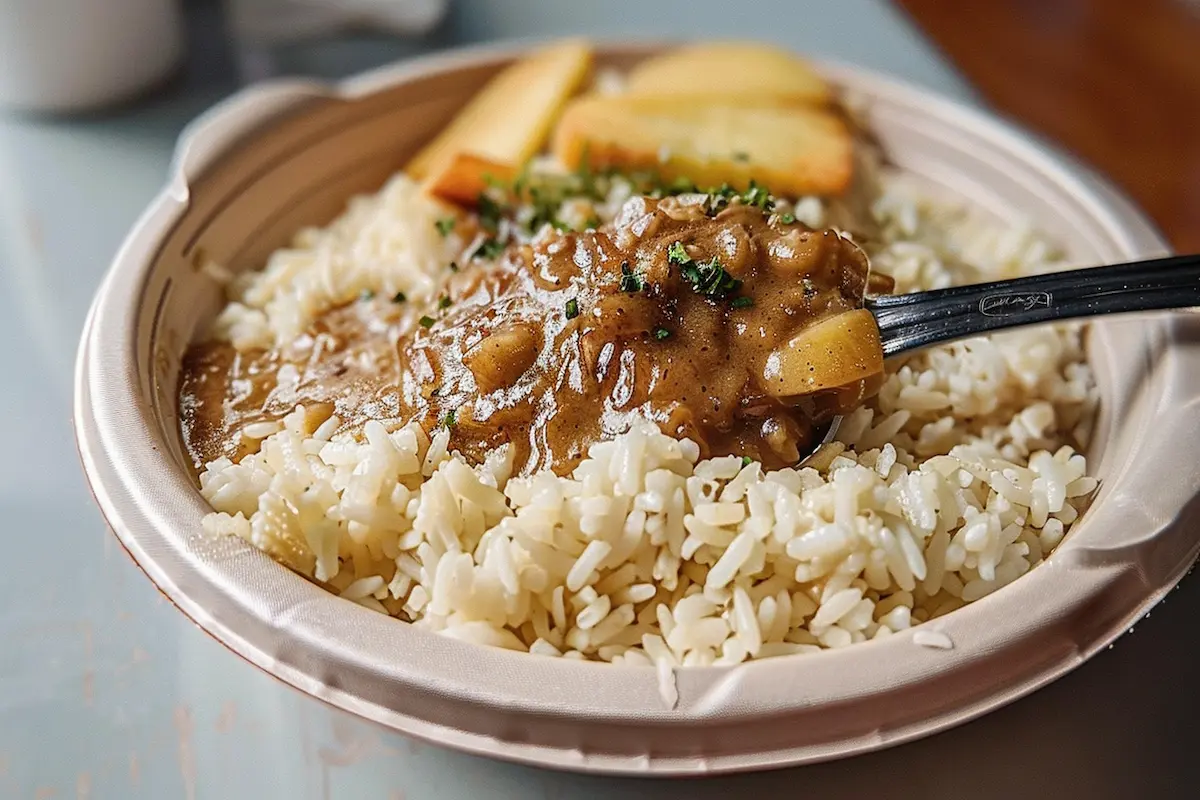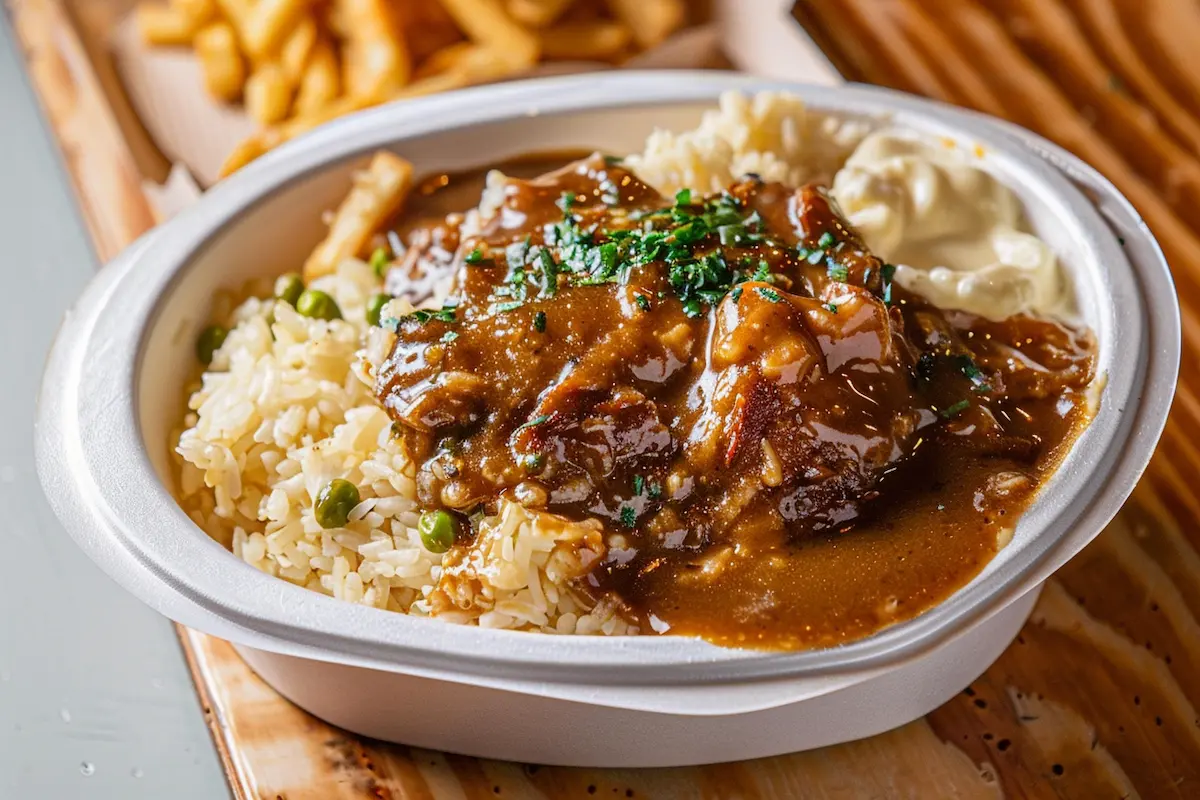Introduction
Rice and gravy is more than a meal—it’s a rich and hearty representation of Southern tradition, warmth, and hospitality. Whether served as a quick weekday dinner or as the centerpiece of a special family meal, this simple yet comforting dish is universally loved. In the South, rice and gravy represents home, comfort, and the kind of food that brings people together.
In this extended guide, we’ll dive deeper into the history, explore various regional and international variations, provide tips for perfecting the dish, and share more pairing and serving suggestions. We’ll also answer frequently asked questions and give tips for making rice and gravy a little healthier without sacrificing flavor. So, if you’re ready, let’s continue our culinary journey into the rich and savory world of rice and gravy.

A Deeper Look Into the History of Rice and Gravy
Rice in Southern Cuisine
Rice has been a staple food in Southern cuisine for centuries, dating back to the early days of colonization when rice was first introduced to North America via the transatlantic slave trade. It quickly became a key crop, especially in the coastal plains of the Carolinas and Louisiana. The cultivation of rice in these areas was due to the subtropical climate and swampy lowlands, perfect conditions for rice paddies.
Rice was inexpensive, versatile, and could be stored for long periods, making it a valuable staple for working-class families. Over time, rice began to feature heavily in Southern cuisine, often cooked in large batches and paired with a variety of sauces, meats, and stews.
As rice became a Southern dietary cornerstone, so too did the invention of gravy—a simple, yet flavorful sauce made from meat drippings and thickened with flour. The combination of rice and gravy became a necessity for families living in the rural South, particularly among sharecroppers and those with limited access to fresh ingredients.
The Emergence of Gravy
Gravy, as we know it today, came into existence out of necessity. In the 19th and early 20th centuries, meat was often a luxury that many households couldn’t afford every day. When families did cook meat, nothing went to waste. Gravy was born from this mindset—it was a practical way to extend the flavors of a small portion of meat and make a dish more filling. By using the drippings from roasted or fried meat and combining them with flour, water, or broth, families created a delicious and economical sauce that added richness to even the simplest meal.
Cajun and Creole Influences on Rice and Gravy
If you travel to Louisiana, rice and gravy takes on a whole new life. Influenced by both Cajun and Creole cooking traditions, Louisiana-style rice and gravy is often made with a deep, rich roux and served with meats like chicken, sausage, pork, or beef. Cajun versions of the dish tend to be heartier, spicier, and full of smoky flavors from meats like andouille sausage or smoked tasso.
Creole versions of rice and gravy may incorporate a more refined mix of flavors, often using a tomato-based gravy or a mix of fresh herbs. Understanding Southern Staples: Dirty Rice, Cajun Rice, and Jambalaya offers a deep dive into these staples of Southern cuisine.
No matter which style you prefer, both Cajun and Creole rice and gravy emphasize the importance of layering flavors and building a deep, rich sauce that pairs perfectly with fluffy white rice.
International Variations
Though rice and gravy is a dish that is strongly associated with Southern American cooking, versions of this classic combination can be found in many cultures around the world. Let’s take a quick tour of how other countries interpret their own versions of rice and gravy:
- Curry and Rice (India): In Indian cuisine, gravy-like sauces (often called “curries”) are typically made from a base of spices, onions, and tomatoes and paired with rice. Whether it’s a rich chicken curry or a vegetarian lentil dal, the combination of a flavorful gravy and basmati rice is essential to Indian meals.
- Cuban Picadillo: Picadillo is a traditional Cuban dish made with ground beef, tomatoes, raisins, and spices. It’s served over white rice with a gravy-like sauce formed from the tomatoes and beef juices.
- Japanese Curry Rice: Japanese curry is a milder, slightly sweeter variation of curry, served with sticky white rice. The gravy-like sauce is made with a mix of vegetables, meat, and a thickening agent, often paired with fried cutlets for a satisfying meal.
- Chinese Braised Meat and Rice: In Chinese cuisine, soy-based braised meat gravies are poured over steamed white rice, making for a flavorful and savory combination that is popular in home-cooked meals across the country.
The global presence of rice and gravy-style dishes highlights the universal appeal of this simple yet versatile meal combination.
Tips for Perfecting Your Rice and Gravy
The key to great rice and gravy is balancing flavors, textures, and cooking techniques. Here are some tips to ensure your dish comes out perfectly every time.
1. Cooking the Rice
While the gravy might be the star of the dish, poorly cooked rice can ruin the entire meal. Here are a few tips to ensure your rice is light, fluffy, and perfectly cooked:
- Rinse the Rice: Rinsing rice before cooking removes excess starch and helps prevent it from becoming sticky. For long-grain rice like basmati or jasmine, this step is especially important.
- The Right Water-to-Rice Ratio: Different types of rice require different amounts of water. Long-grain white rice usually needs a 2:1 water-to-rice ratio, while brown rice may need more water and longer cooking time.
- Fluff the Rice: Once your rice is fully cooked, let it rest for about 5 minutes, then fluff it with a fork to separate the grains. This will make your rice perfect for soaking up all the gravy goodness.
2. Making a Roux
A roux is a simple mixture of fat and flour that acts as a thickening agent for your gravy. Here are a few tips to help you make the perfect roux:
- Low and Slow: When making a roux, patience is key. Cook it over medium to low heat to ensure even browning without burning. A golden-brown roux will give your gravy a deep, nutty flavor.
- Watch for the Right Color: Depending on the type of gravy you’re making, you may want a light roux (for a creamier gravy) or a dark roux (for a richer, more intense flavor). Darker roux is commonly used in Cajun and Creole cooking.
3. Layering Flavors
Don’t be afraid to layer your flavors to build a more complex and rich gravy. Add in aromatics like onions, garlic, and herbs to elevate the taste. If you’re cooking meat, make sure to brown it well to build those flavorful fond (the brown bits at the bottom of the pan) that will add depth to your gravy.
Using stock or broth instead of water is another way to add richness to your gravy. Chicken, beef, or vegetable broth can help enhance the flavors, making your rice and gravy more delicious.
4. Adjusting Thickness
Everyone has their own preference when it comes to gravy consistency. Some prefer it thick and hearty, while others like a thinner sauce that can really soak into the rice. If your gravy is too thick, add a little more broth to thin it out. If it’s too thin, cook it down a little longer or add a small slurry of water and flour or cornstarch to thicken it up.
5. Experiment with Add-ins
While the classic version of rice and gravy focuses on simplicity, there are plenty of ways to add a personal touch to the dish:
- Vegetables: Adding vegetables like mushrooms, carrots, or celery can give your gravy more texture and depth.
- Spices: Play around with spices like smoked paprika, cayenne, or thyme to create unique flavor profiles.
- Meat Additions: Bacon, sausage, or smoked ham can be great additions for a meatier flavor.
For inspiration on how to combine flavors and ingredients, check out recipes like Delicious Rotisserie Chicken Recipes: Easy and Flavorful Meals that pair beautifully with rice and gravy.

Healthier Versions of Rice and Gravy
Though rice and gravy is typically a comfort food with a focus on richness and indulgence, it’s possible to create healthier versions without compromising on flavor. Here are some tips to make a more nutritious version of rice and gravy:
1. Choose Brown Rice or Quinoa
Brown rice is a whole grain that provides more fiber, vitamins, and minerals than white rice. Quinoa is another great option, offering a high protein content along with essential amino acids. Both of these options can add a more substantial nutritional profile to your meal.
2. Use Lean Meats or Plant-Based Proteins
Opt for lean cuts of meat like chicken breast or turkey instead of fattier cuts like pork or beef. You can also use plant-based alternatives like lentils, mushrooms, or tofu to create a vegetarian version that’s still hearty and delicious.
3. Reduce Fat Content in the Gravy
Instead of using the full-fat drippings or butter to make your gravy, consider using a smaller amount of olive oil or low-sodium broth. You can also substitute part of the flour with whole wheat flour or cornstarch to create a lighter, but still flavorful, roux.
4. Add Vegetables for Nutritional Boost
Incorporating more vegetables into your rice and gravy dish can significantly increase its nutritional value. Adding sautéed spinach, roasted bell peppers, or zucchini can provide extra vitamins, minerals, and fiber, while also adding color and texture.
For those seeking more comforting yet nutritious options, Mississippi Mud Potatoes: A Rich Comforting Side Dish could be an ideal complement to healthier rice and gravy.
Serving Suggestions and Pairings
Rice and gravy is a dish that goes beyond the basics—it’s versatile enough to be served on its own or as part of a larger meal. Here are some ideas for side dishes and accompaniments to take your meal to the next level.
Classic Southern Sides
- Collard Greens: Slow-cooked collard greens with a bit of smoked bacon or ham hock are a perfect companion to rice and gravy. The smoky, savory flavors complement the richness of the gravy while adding a nutritional boost.
- Cornbread: A warm piece of homemade cornbread adds texture and sweetness to balance out the savory gravy. The crumbly bread also serves as a vessel for soaking up any leftover sauce.
- Macaroni and Cheese: Creamy mac and cheese is another beloved Southern side that pairs well with the flavors of rice and gravy. The richness of the cheese adds an indulgent element to the meal.
For more side dish inspiration, Mississippi Mud Potatoes is a great starting point for complementing rice and gravy.
Beverage Pairings
While rice and gravy is a down-home meal, it can still benefit from thoughtful beverage pairings. Here are a few drink ideas to enhance your dining experience:
- Sweet Tea: A classic Southern beverage, sweet tea provides a refreshing contrast to the rich flavors of rice and gravy.
- Beer: A light beer or amber ale can pair nicely with the salty and savory components of the dish. For a Cajun-style rice and gravy, a cold lager works perfectly to wash down the spices.
- Red Wine: For those who enjoy wine with their meals, a medium-bodied red like Merlot or Zinfandel can complement the richness of the gravy without overwhelming the palate.
Frequently Asked Questions
Q: Can I make rice and gravy ahead of time?
Absolutely! Both the rice and the gravy can be made ahead of time and stored in the fridge for up to 3 days. To reheat, simply add a bit of water or broth to the gravy to loosen it up, then warm both the rice and gravy on the stovetop or in the microwave.
Q: Can I freeze leftover rice and gravy?
Yes! Rice and gravy freeze well. Store the rice and gravy in separate containers, then reheat on the stovetop or in the microwave when ready to serve. Just make sure to add a little extra liquid to the gravy as it may thicken after freezing.
Q: What’s the best way to thicken gravy without flour?
If you’re avoiding flour, you can use cornstarch or arrowroot powder to thicken your gravy. Simply mix a tablespoon of cornstarch or arrowroot with a small amount of cold water to form a slurry, then add it to the gravy while it’s simmering.
Q: Can I make rice and gravy in a slow cooker?
Yes, rice and gravy can be made in a slow cooker. You can prepare the meat and gravy together in the slow cooker, allowing the flavors to meld as the dish cooks slowly. You can then serve the gravy over freshly cooked rice when ready to eat.

Final Thoughts: A Dish That Stands the Test of Time
Rice and gravy is more than just a meal—it’s a symbol of comfort, family, and the kind of cooking that brings people together. Whether you stick to the traditional version or put your own spin on it, rice and gravy is sure to be a hit. With its versatility, affordability, and endless flavor possibilities, it’s no wonder this dish remains a Southern staple to this day.
So, next time you’re in the kitchen, whip up a batch of rice and gravy, and don’t forget to try it with Dirty Rice Recipe: How to Make the Perfect Creole Dish or pair it with some Delicious Rotisserie Chicken Recipes. You won’t be disappointed.
Print
Rice and Gravy: The Ultimate Southern Comfort Dish
- Total Time: 30 minutes
- Yield: 4–6 servings 1x
Description
Rice and gravy is a simple yet flavorful Southern comfort food that combines fluffy rice with a rich, savory gravy made from meat drippings or broth. This dish is perfect for weeknight dinners or large family gatherings. Customize it with your favorite proteins, vegetables, and spices for a satisfying meal that never disappoints.
Ingredients
For the Rice:
- 2 cups long-grain white rice (or brown rice for a healthier option)
- 4 cups water or chicken broth
- 1/2 teaspoon salt
For the Gravy:
- 2 tablespoons of meat drippings (from chicken, beef, or pork) or 2 tablespoons of butter
- 2 tablespoons all-purpose flour
- 2 cups beef, chicken, or vegetable broth
- 1 small onion, finely chopped (optional)
- 2 cloves garlic, minced (optional)
- Salt and pepper to taste
- Optional: thyme, rosemary, or smoked paprika for added flavor
Instructions
For the Rice:
- Rinse the Rice: Rinse the rice under cold water to remove excess starch.
- Cook the Rice: In a medium pot, bring the water or broth to a boil. Add salt and rice, cover, and reduce heat to low. Cook for 18-20 minutes, or until the liquid is absorbed and the rice is tender.
- Fluff: Remove from heat, let the rice sit for 5 minutes, and then fluff with a fork.
For the Gravy:
- Prepare the Roux: In a medium saucepan, heat the meat drippings or butter over medium heat. Add the flour and whisk continuously for 2-3 minutes until the roux turns golden brown.
- Add Aromatics (Optional): If using, add chopped onions and garlic to the roux and cook for an additional 3 minutes until soft and fragrant.
- Add Broth: Gradually whisk in the broth, ensuring no lumps form. Continue stirring as the mixture thickens.
- Season: Add salt, pepper, and any additional seasonings (thyme, rosemary, smoked paprika).
- Simmer: Let the gravy simmer for 5-10 minutes, stirring occasionally until it reaches your desired consistency.
- Serve: Spoon the gravy over the cooked rice and serve immediately.
Notes
- Add Vegetables: Add sautéed mushrooms, bell peppers, or carrots to the gravy for extra texture and flavor.
- Healthier Version: Use olive oil instead of butter and opt for brown rice or quinoa for a healthier version of the dish.
- Storage: Store leftovers in an airtight container in the refrigerator for up to 3 days. Reheat on the stove, adding a splash of broth to loosen the gravy if needed.
- Spice it Up: For a spicy kick, add cayenne pepper or hot sauce to the gravy during the seasoning step.
- Prep Time: 10 minutes
- Cook Time: 20 minutes
- Category: Main Course
- Cuisine: Southern, American
Nutrition
- Calories: 320 kcal
- Sugar: 2g
- Sodium: 680mg
- Fat: 12g
- Saturated Fat: 4g
- Carbohydrates: 45g
- Fiber: 2g
- Protein: 6g
- Cholesterol: 10mg

